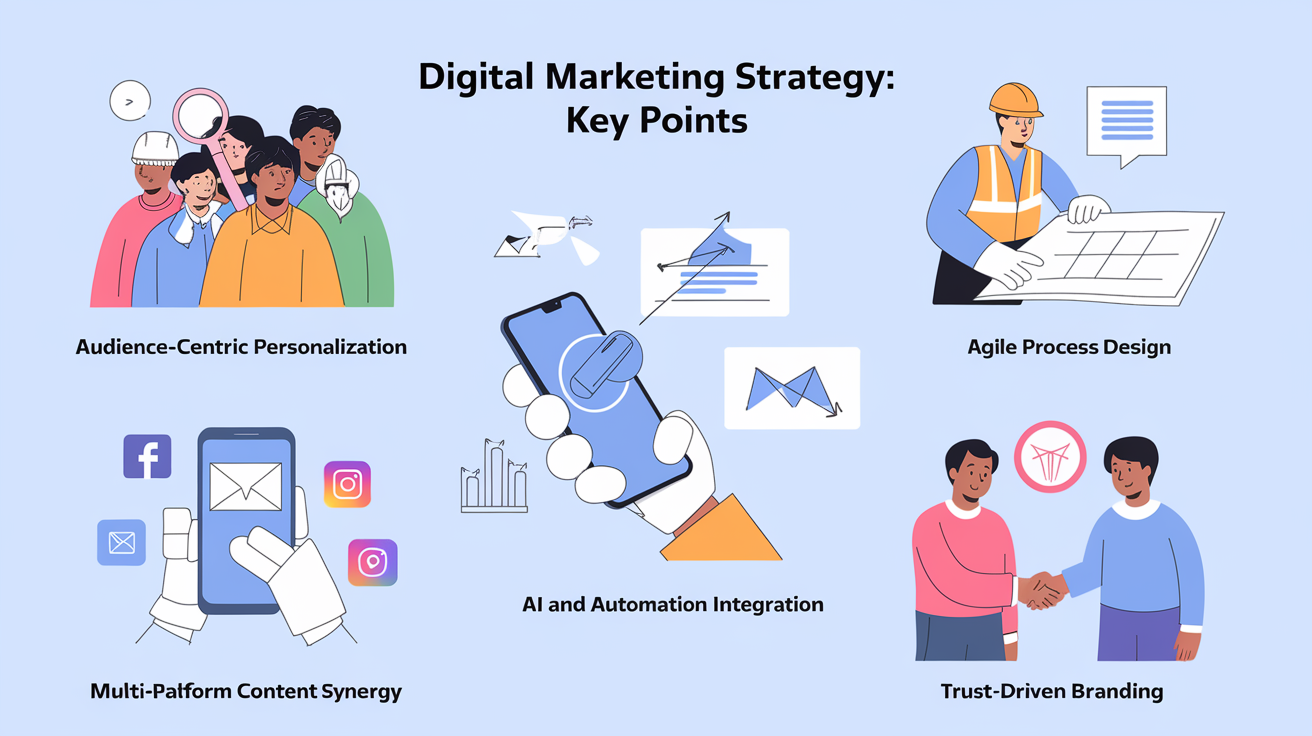How to Create a Digital Marketing Strategy for Your Company in 2025
Your business struggles to stand out online. Customers scroll past your ads, and your website barely gets clicks. In 2025, with AI reshaping the marketing and consumer habits shifting, falling behind feels inevitable. Without a clear digital marketing strategy, you are wasting budgets on ineffective campaigns. Competitors steal your audience with personalized ads and viral TikTok videos while you’re stuck with outdated tactics. Develop a comprehensive digital marketing strategy for 2025 by leveraging AI, personalized content, and emerging social media trends to drive growth and engagement.
Whether you’re a startup, small business, or enterprise, this article covers digital marketing strategy and planning, online marketing strategies for small businesses, and the best digital marketing strategies for business growth.
Why Your Business Needs a 2025- Digital Strategy
A strong strategy drives results in crowded markets. Businesses using AI-powered campaigns see 64% better ROI, and Instagram’s shoppable posts boost sales by 30%. Without a plan, you’re burning cash as algorithms shift and audiences demand authenticity.
Personalized campaigns lift conversions by 20%, and trust-driven branding builds loyalty. Let us break down how to make it happen.
Core Components of a 2025 Digital Marketing Strategy
1. Audience-Centric Personalization
Personalization dominates 2025 marketing. Tailor content using location data, purchase history, and browsing habits. For example, segment email campaigns by customer interests or send abandoned cart reminders with dynamic product images. Tools like AI analytics predict user preferences, enabling hyper-relevant offers that convert.
2. Agile Process Design
Adopt the 4 Ps framework: Process, People, Platforms, and Performance. Map customer journeys, review strategies monthly, and track interactions with CRMs. Adapt fast to trends like voice search or immersive AR ads. Use platforms like CRM systems to track interactions and adjust campaigns in real time. Document every decision to refine future efforts.
3. AI and Automation Integration
AI streamlines tasks from ad targeting to content creation.Chatbots handle queries instantly, saving 70% of response time.Machine learning shifts ad budgets to high-ROI channels, like moving funds from Facebook to trending TikTok shorts.
4. Multi-Platform Content Synergy
Utilize short-form videos to boost engagement, as they generate three times more interaction compared to static content. Transform your TikTok videos into Instagram Reels, and enhance them with product tags that allow users to shop directly from your content. Pair these with shoppable tags that let users buy directly from posts. Complement videos with user-generated content (UGC) campaigns, which boost trust by 48%.
5. Trust-Driven Branding
Authenticity wins in 2025. A digital marketing strategy for local business might highlight customer testimonials or partner with micro-influencers for relatable campaigns.
For example, a skincare brand might showcase real customers’ transformation videos instead of polished ads.

Step-by-Step Guide to Building Your 2025 Strategy
Step 1: Audit Current Performance
Analyze past campaigns using Google Analytics and social insights. Identify top traffic sources, bounce rates, and ROI per channel. Compare results against industry benchmarks. For instance, if email open rates lag behind the 21% average, test new subject lines or segment lists tighter.
Step 2: Define Clear Objectives
Every digital marketing strategy plan starts with clear business goals. Set SMART goals: Specific, Measurable, Achievable, Relevant, Time-bound. Tracking key performance indicators (KPIs) is essential to measuring success. Below are five crucial metrics to monitor:
- Website traffic growth – Measures your SEO efforts.
- Conversion rate – Indicates how much visitors turn into customers
- Social media engagement – Tracks audience interaction with your content.
- Customer acquisition cost (CAC) – This metric helps you understand the total amount you spend to bring in each new customer.
- Return on ad spend (ROAS) – Calculates ad profitability.
Examples:
- Increase organic traffic by 40% in 6 months via SEO.
- Reduce cost per lead by 25% through refined PPC targeting.
- Grow Instagram sales by 30% using shoppable posts.
By setting clear goals and tracking performance, businesses can ensure their digital marketing strategy implementation and practice remain data-driven and results-oriented.
Step 3: Research Your Audience
A successful digital marketing business plan begins with a deep understanding of your audience. To create a buyer persona, consider:
- Demographics – Age, gender, income, and location.
- Pain Points – What problems can your product or service can be able to solve?
- Online Habit – Discover your audience’s online patterns by identifying the social media platforms where they spend the most time and how they interact with the content there
- Buying Patterns – What influences their purchasing decisions?
For example, if you’re working on a digital marketing strategy for small businesses, your target audience might include local entrepreneurs looking for affordable and effective ways to reach customers online.
Several tools can help refine audience insights:
1. Google Analytics – Analyzes user demographics and behavior.
2. Facebook Audience Insights – Helps understand social media preferences.
3. Survey tools (Google Forms, Typeform) – Collect direct customer feedback.
Understanding your target audience ensures that your digital marketing strategy development is customer-focused and delivers maximum impact.
Step 4: Analyze Your Competitors
Analyze competitors’ blogs, ads, and reviews. Studying their tactics can help identify market gaps and uncover opportunities for differentiation.
To conduct a thorough competitor analysis:
- Figure out direct competitors – These businesses are ones we should target the same audience with similar products or services.
- Analyze their content strategy – Check their blogs, videos, and social media presence to analyze the type of content that resonates with their audience.
- Evaluate their SEO efforts – Use tools like SEMrush or Ahrefs to analyze their keywords and backlinks.
- Monitor their paid ads – Study their ad placements and messaging strategies.
- Check their customer feedback – Reviews on platforms like Google and social media reveal their strengths and weaknesses.
For example, if you’re building a digital marketing agency, analyzing successful agencies will help you craft unique service offerings that set you apart.
Step 5: Select High-Impact Channels
Prioritize platforms where your audience spends time. A B2B SaaS company might focus on LinkedIn and case studies, while a fashion retailer targets Instagram and TikTok. Allocate 60% of budgets to proven channels and 40% to experimental tactics like AR filters or interactive polls.
Step 6: Create a Content Engine
Develop a 90-day content calendar blending educational, promotional, and UGC posts. For example:
- Week 1: Blog on industry trends.
- Week 3: Share a customer success video testimonial.
- Week 6: Launch a TikTok challenge with branded hashtags.
Use AI tools like Jasper to draft blog outlines or Canva for quick graphic designs.
Step 7: Implement and Monitor
Launch campaigns in phases. Track metrics like click-through rates, conversion paths, and customer lifetime value. Hold biweekly team reviews to troubleshoot issues. If a webinar series is not delivering results, consider switching to live Q&A sessions or offering downloadable resources to better engage your audience.
Step 8: Optimize Relentlessly
A/B test ad creatives, email layouts, and CTAs. For instance, try emojis vs. plain text in subject lines. Use heatmaps to refine website layouts.Use Smart Bidding in Google Ads to automatically adjust bids and boost conversions based on user behavior.

Critical Tools for 2025 Success
- AI Analytics Platforms: Tools like HubSpot predict customer behavior and automate reports.
- Unified Dashboards: Centralize data from Meta, Google, and email campaigns in tools like Tableau.
- SEO Suites: SEMrush or Ahrefs track rankings and uncover keyword gaps.
- Social Schedulers: Buffer or Hootsuite manage cross-platform posts and engagement.
Digital Marketing Strategy and Planning: The Framework
A digital marketing strategy framework ties everything together. Here’s a simple one for 2025:
- Research: Leverage analytics to gain insight into what your audience truly values and keep an eye on competitors to spot new opportunities.
- Plan: Set SMART goals and map content to customer journeys.
- Execute: Launch campaigns across chosen platforms with clear KPIs.
- Analyze: Track performance weekly and adjust based on data.
- Optimize: Test variables and scale what works.
For digital marketing strategy services, this framework ensures every campaign aligns with business goals. Agencies use it to deliver measurable results, like cutting ad waste by 20% or boosting leads by 50%.
Avoid These 2025 Strategy Pitfalls
- Ignoring Privacy Laws: With stricter data regulations, obtain explicit consent for tracking. Offer value exchanges like discounts for email sign-ups.
- Do not Ignore Mobile Users: With 68% of web traffic coming from smartphones, optimizing for mobile is essential.
- Static Content: Update blogs and videos quarterly to maintain SEO rankings. Refresh stats, add new examples, and expand sections.
Future-Proofing Your Strategy
Stay ahead by:
- Attending quarterly webinars on AI marketing trends.
- Subscribing to newsletters like Search Engine Journal for algorithm updates.
- Networking in communities like LinkedIn’s Digital Marketing groups.
A winning 2025 strategy blends innovation with fundamentals. Start with deep audience insights, leverage AI responsibly, and iterate based on data. Companies that master this balance will dominate their niches and drive sustainable growth. Begin auditing your current efforts today,your future customers await.
Conclusion
No one is born as a digital marketing strategist. Even the strategy I worked out has failed several times. Each strategy is a trial and error method, we can learn a lot from each strategy. All we have to do is discover why the specific strategy did not work out.
Creating a digital marketing strategy for your company in 2025 requires a combination of SEO, content marketing, social media, and automation. Following these steps, you can develop a data-driven digital marketing business strategy that enhances brand visibility, attracts customers, and drives sustainable growth. If you are not aware of how to create a winning strategy, we can help you to create a strategy for you. Send your queries in the Contact Us form.





1 Comment
Why UK Businesses Should Hire a Digital Marketing Agency
[…] to turn clicks into customers. What is the difference between stagnation and growth? A sharp digital marketing strategy. Hiring a digital marketing agency in 2025 can boost your UK business’s online presence, […]